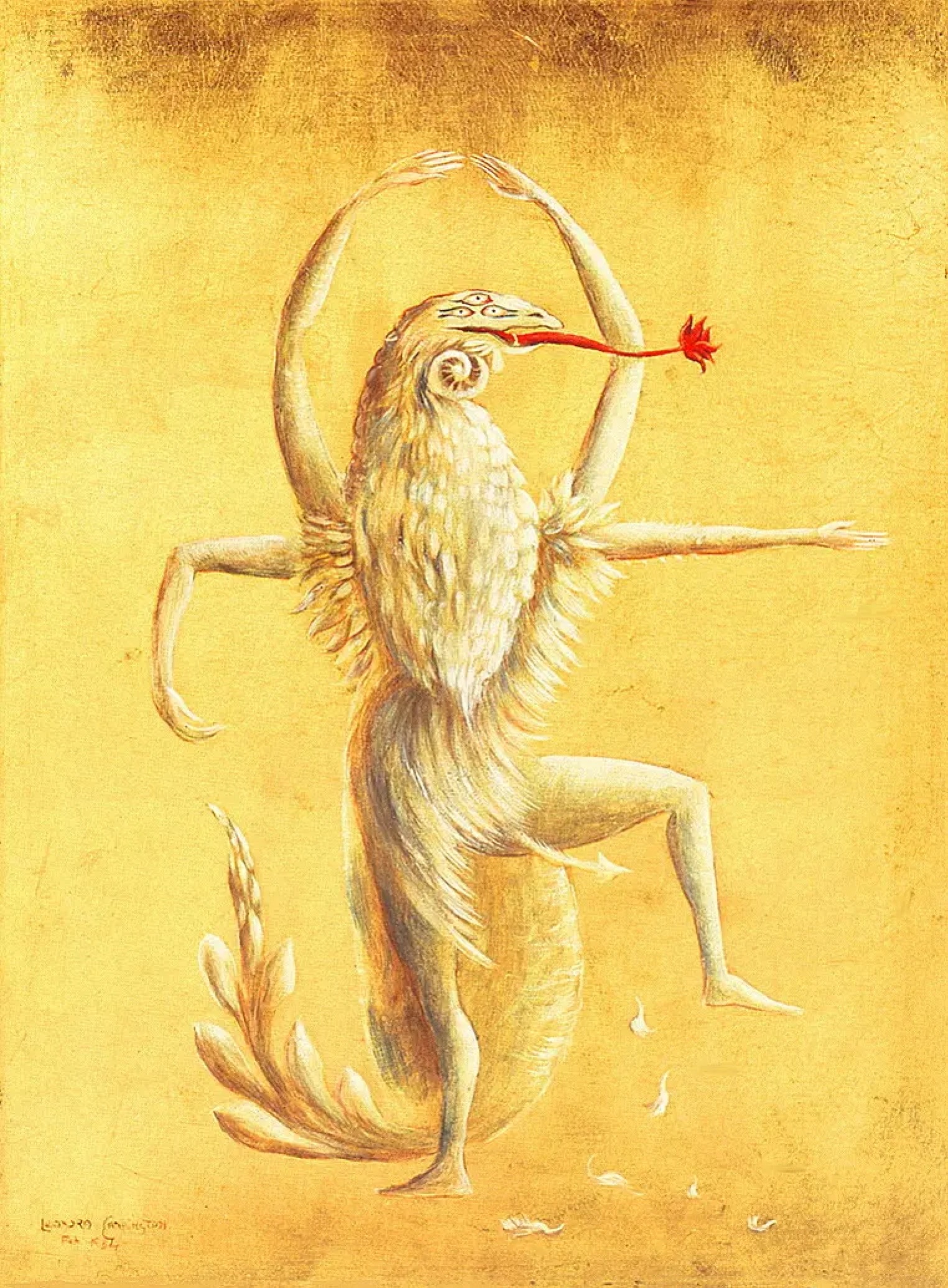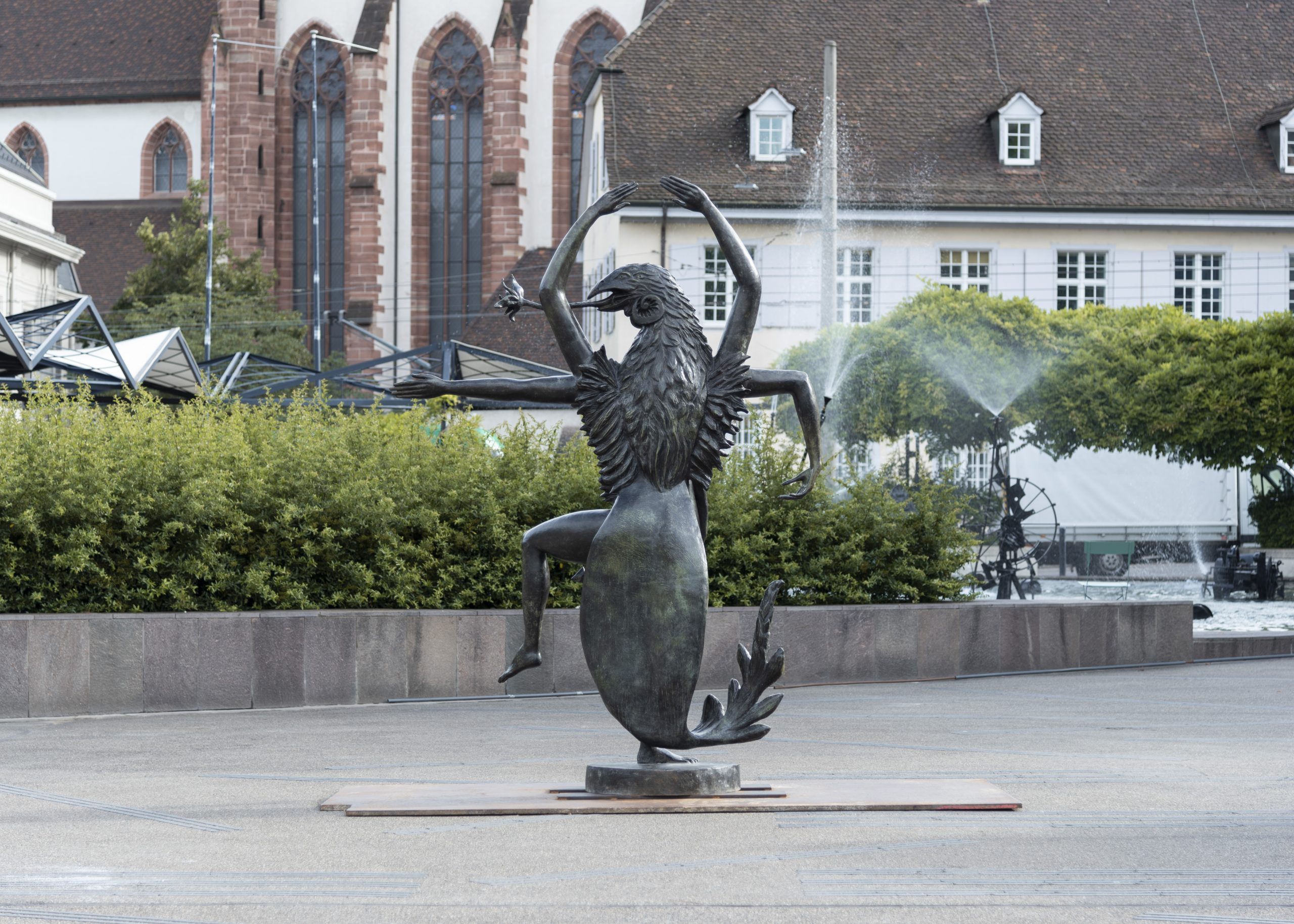Basel, Switzerland
Leonora Carrington
surrealist sculpture unveiling
at Theaterplatz
10 June – 17 June 2024
I am interested in being felt.”
Leonora Carrington

Leonora Carrington, Figuras Miticas: Bailarin II, 1954, oil on masonite.
rossogranada is delighted to unveil this year at Theaterplatz of Basel, The Dancer (El Bailarín) by Leonora Carrington, celebrating the 100 th anniversary of the Surrealist Manifesto with a sculpture that comes on display for the first time in both
Switzerland and Europe.
The postwar movement of Surrealism which was to eventually become widespread, was an art and culture statement of a cluster of artists based in France and Belgium that placed
emphasis in the workings of the subconscious and in the words of the founding figure André Breton, the ‘pure psychic automatism’. A predecessor to Surrealism was the Dada
movement which sprang out of Switzerland in 1916 at the Cabaret Voltaire of Zurich, established by the German author and poet Hugo Ball.
Carrington mastered the art of sculpture from as early as 1938 up until her death in 2011, and in the decades in-between she dedicated herself to explore her artistic possibilities with all kinds of materials, starting from plaster as a young artist, moving to wood (1940s & 50s)
when she collaborated with Jose Horna, a master wood carver from Mexico who specialized in cedar and mahogany woods. During these two decades Carrington made several commissioned sculptures amongst them Cat Woman that she made for Edward James, and
it is one of the most well-known sculptures by the artist.
About the project
In the 1960s, Carrington started exploring the possibilities of various types of concrete which she reinforced with steel mesh a period that went well into the 1970s when she made her first bronze sculpture in New York City. In 1975 Carrington started working with precious metals and she created her first silver sculpture, a puppet titled La Vaca. In the 1980s, Carrington resumes her sculptural work in concrete and from now on, many of the sculptures originally made in cement in the previous decades, she subsequently started making in bronze, using different dimensions and for the first time she introduces editions. In the 1990 and 2000s all the way to 2011, Carrington created a series of bronze sculptures taking inspiration from imaginary creatures she first created in her painterly and literary works.
El Bailarín (which translates as The Dancer) is a late period life cast bronze sculpture by Leonora Carrington that depicts an otherworldly archetypal mythical creature in an imposing dancing posture, derivative of her characteristic iconography. The figure of The Dancer first appeared in her paintings in the 1950s, specifically in the 1954 painting titled Figuras Míticas, Dancer II, which was most recently exhibited at the 2018 major Leonora Carrington retrospective titled Cuentos Magicos at Museum of Modern Art in Mexico City. Preparatory work on The Dancer as a supplementary character can be seen in the upper right corner of the 1953 painting And then We Saw the Daughter of the Minotaur! where a fainted human-like character is seemingly dancing in the same pose with the Dancer. The sculpture has a plethora of atributes uniting Mayan pagan elements with Celtic mythology, bringing to the three-dimensional contemporary experience an art history tradition that can be traced back to pagan ancient civilisations and throughout the centuries, pursuing the freedom of imagination and spirit and ultimately the joy of life.
The Dancer, Leonora Carrington at Theaterplatz in June 2024. ©rossogranada
Leonora Carrington
surrealist sculpture unveiling
at Theaterplatz
“I am not interested in being understood.
I am interested in being felt.”
- Leonora Carrington

Leonora Carrington, Figuras Miticas: Bailarin II, 1954, oil on masonite.
rossogranada is delighted to unveil this year at Theaterplatz of Basel, The Dancer (El Bailarín) by Leonora Carrington, celebrating the 100 th anniversary of the Surrealist Manifesto with a sculpture that comes on display for the first time in both
Switzerland and Europe.
The postwar movement of Surrealism which was to eventually become widespread, was an art and culture statement of a cluster of artists based in France and Belgium that placed
emphasis in the workings of the subconscious and in the words of the founding figure André Breton, the ‘pure psychic automatism’. A predecessor to Surrealism was the Dada
movement which sprang out of Switzerland in 1916 at the Cabaret Voltaire of Zurich, established by the German author and poet Hugo Ball.
Carrington mastered the art of sculpture from as early as 1938 up until her death in 2011, and in the decades in-between she dedicated herself to explore her artistic possibilities with all kinds of materials, starting from plaster as a young artist, moving to wood (1940s & 50s)
when she collaborated with Jose Horna, a master wood carver from Mexico who specialized in cedar and mahogany woods. During these two decades Carrington made several commissioned sculptures amongst them Cat Woman that she made for Edward James, and
it is one of the most well-known sculptures by the artist.
About the project
In the 1960s, Carrington started exploring the possibilities of various types of concrete which she reinforced with steel mesh a period that went well into the 1970s when she made her first bronze sculpture in New York City. In 1975 Carrington started working with precious metals and she created her first silver sculpture, a puppet titled La Vaca. In the 1980s, Carrington resumes her sculptural work in concrete and from now on, many of the sculptures originally made in cement in the previous decades, she subsequently started making in bronze, using different dimensions and for the first time she introduces editions. In the 1990 and 2000s all the way to 2011, Carrington created a series of bronze sculptures taking inspiration from imaginary creatures she first created in her painterly and literary works.
El Bailarín (which translates as The Dancer) is a late period life cast bronze sculpture by Leonora Carrington that depicts an otherworldly archetypal mythical creature in an imposing dancing posture, derivative of her characteristic iconography. The figure of The Dancer first appeared in her paintings in the 1950s, specifically in the 1954 painting titled Figuras Míticas, Dancer II, which was most recently exhibited at the 2018 major Leonora Carrington retrospective titled Cuentos Magicos at Museum of Modern Art in Mexico City. Preparatory work on The Dancer as a supplementary character can be seen in the upper right corner of the 1953 painting And then We Saw the Daughter of the Minotaur! where a fainted human-like character is seemingly dancing in the same pose with the Dancer. The sculpture has a plethora of atributes uniting Mayan pagan elements with Celtic mythology, bringing to the three-dimensional contemporary experience an art history tradition that can be traced back to pagan ancient civilisations and throughout the centuries, pursuing the freedom of imagination and spirit and ultimately the joy of life.



